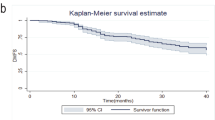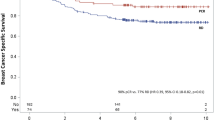Abstract
Patients who achieve a pathological complete response (pCR) after neoadjuvant therapy, including chemotherapy with or without trastuzumab (NAT) have better outcomes than patients with residual disease. Despite the excellent prognosis associated with achieving a pCR, tumors still recur. The objective of this study was to evaluate factors associated with tumor recurrence and survival among patients achieving pCR after NAT. We identified 749 patients with primary breast cancer who achieved pCR after NAT between 1988 and 2009. pCR was defined as no evidence of invasive cancer in the breast and ipsilateral axillary lymph nodes on pathological evaluation. The Kaplan–Meier product limit method and multivariate Cox proportional hazards models were used to determine the association between clinical and demographic factors and outcomes. Median follow-up was 35 months (range, 1–258 months). Overall 5-year distant metastasis-free survival was 93 % (95 % confidence interval [CI], 90–95 %) and 5-year overall survival (OS) was 96 % (95 % CI, 93–97 %). In the multivariable model, we observed that patients >50 years had significantly decreased risk of distant metastasis (hazard ratio [HR] 0.47; 95 % CI, 0.22–0.98) and that patients with clinical stage at diagnosis IIIB–C cancer had both an increased risk of distant metastasis (HR 3.92; 95 % CI, 1.54–10.00) and lower OS (HR 4.75; 95 % CI, 1.60–14.08). Patients with pCR after NAT have excellent outcomes. However, our data show that younger patient and those with clinical stage at diagnosis IIIB and IIIC cancers are at increased risk of developing distant metastasis.

Similar content being viewed by others
References
Chia S, Swain SM, Byrd DR, Mankoff DA (2008) Locally advanced and inflammatory breast cancer. J Clin Oncol 26:786–790
Liu SV, Melstrom L, Yao K et al (2010) Neoadjuvant therapy for breast cancer. J Surg Oncol 101:283–291
Berruti A, Brizzi MP, Generali D et al (2008) Presurgical systemic treatment of nonmetastatic breast cancer: facts and open questions. Oncologist 13:1137–1148
Kaufmann M, von Minckwitz G, Bear HD et al (2007) Recommendations from an international expert panel on the use of neoadjuvant (primary) systemic treatment of operable breast cancer: new perspectives 2006. Ann Oncol 18:1927–1934
Mieog JS, van der Hage JA, van de Velde CJ (2007) Preoperative chemotherapy for women with operable breast cancer. Cochrane Database Syst Rev Cd005002
Teshome M, Hunt KK (2014) Neoadjuvant therapy in the treatment of breast cancer. Surg Oncol Clin N Am 23:505–523
Prowell TM, Pazdur R (2012) Pathological complete response and accelerated drug approval in early breast cancer. N Engl J Med 366:2438–2441
Rastogi P, Anderson SJ, Bear HD et al (2008) Preoperative chemotherapy: updates of national surgical adjuvant breast and bowel project protocols B-18 and B-27. J Clin Oncol 26:778–785
Cortazar P, Zhang L, Untch M et al (2014) Pathological complete response and long-term clinical benefit in breast cancer: the CTNeoBC pooled analysis. Lancet 384:164–172
Bonnefoi H, Litiere S, Piccart M et al (2014) Pathological complete response after neoadjuvant chemotherapy is an independent predictive factor irrespective of simplified breast cancer intrinsic subtypes: a landmark and two-step approach analyses from the EORTC 10994/BIG 1-00 phase III trial. Ann Oncol 25:1128–1136
Mieog JS, van der Hage JA, van de Velde CJ (2007) Neoadjuvant chemotherapy for operable breast cancer. Br J Surg 94:1189–1200
Fisher B, Bryant J, Wolmark N et al (1998) Effect of preoperative chemotherapy on the outcome of women with operable breast cancer. J Clin Oncol 16:2672–2685
Kuerer HM, Newman LA, Smith TL et al (1999) Clinical course of breast cancer patients with complete pathologic primary tumor and axillary lymph node response to doxorubicin-based neoadjuvant chemotherapy. J Clin Oncol 17:460–469
Fei F, Messina C, Slaets L et al (2015) Tumour size is the only predictive factor of distant recurrence after pathological complete response to neoadjuvant chemotherapy in patients with large operable or locally advanced breast cancers: a sub-study of EORTC 10994/BIG 1-00 phase III trial. Eur J Cancer 51:301–309
von Minckwitz G, Untch M, Nuesch E et al (2011) Impact of treatment characteristics on response of different breast cancer phenotypes: pooled analysis of the German neo-adjuvant chemotherapy trials. Breast Cancer Res Treat 125:145–156
von Minckwitz G, Untch M, Blohmer JU et al (2012) Definition and impact of pathologic complete response on prognosis after neoadjuvant chemotherapy in various intrinsic breast cancer subtypes. J Clin Oncol 30:1796–1804
Bear HD, Anderson S, Brown A et al (2003) The effect on tumor response of adding sequential preoperative docetaxel to preoperative doxorubicin and cyclophosphamide: preliminary results from National Surgical Adjuvant Breast and Bowel Project Protocol B-27. J Clin Oncol 21:4165–4174
Feldman LD, Hortobagyi GN, Buzdar AU et al (1986) Pathological assessment of response to induction chemotherapy in breast cancer. Cancer Res 46:2578–2581
Tubiana-Hulin M, Stevens D, Lasry S et al (2006) Response to neoadjuvant chemotherapy in lobular and ductal breast carcinomas: a retrospective study on 860 patients from one institution. Ann Oncol 17:1228–1233
Luangdilok S, Samarnthai N, Korphaisarn K (2014) Association between pathological complete response and outcome following neoadjuvant chemotherapy in locally advanced breast cancer patients. J Breast Cancer 17:376–385
Wu K, Yang Q, Liu Y et al (2014) Meta-analysis on the association between pathologic complete response and triple-negative breast cancer after neoadjuvant chemotherapy. World J Surg Oncol 12:95
Tan MC, Al Mushawah F, Gao F et al (2009) Predictors of complete pathological response after neoadjuvant systemic therapy for breast cancer. Am J Surg 198:520–525
Tanioka M, Shimizu C, Yonemori K et al (2010) Predictors of recurrence in breast cancer patients with a pathologic complete response after neoadjuvant chemotherapy. Br J Cancer 103:297–302
Gonzalez-Angulo AM, McGuire SE, Buchholz TA et al (2005) Factors predictive of distant metastases in patients with breast cancer who have a pathologic complete response after neoadjuvant chemotherapy. J Clin Oncol 23:7098–7104
Gianni L, Eiermann W, Semiglazov V et al (2014) Neoadjuvant and adjuvant trastuzumab in patients with HER2-positive locally advanced breast cancer (NOAH): follow-up of a randomised controlled superiority trial with a parallel HER2-negative cohort. Lancet Oncol 15:640–647
Guarneri V, Broglio K, Kau SW et al (2006) Prognostic value of pathologic complete response after primary chemotherapy in relation to hormone receptor status and other factors. J Clin Oncol 24:1037–1044
Ring AE, Smith IE, Ashley S et al (2004) Oestrogen receptor status, pathological complete response and prognosis in patients receiving neoadjuvant chemotherapy for early breast cancer. Br J Cancer 91:2012–2017
Jeruss JS, Mittendorf EA, Tucker SL et al (2008) Combined use of clinical and pathologic staging variables to define outcomes for breast cancer patients treated with neoadjuvant therapy. J Clin Oncol 26:246–252
Mittendorf EA, Jeruss JS, Tucker SL et al (2011) Validation of a novel staging system for disease-specific survival in patients with breast cancer treated with neoadjuvant chemotherapy. J Clin Oncol 29:1956–1962
Funding
None.
Author information
Authors and Affiliations
Corresponding author
Ethics declarations
Conflicts of interest
The authors have no potential conflicts of interest.
Rights and permissions
About this article
Cite this article
Chaudry, M., Lei, X., Gonzalez-Angulo, A.M. et al. Recurrence and survival among breast cancer patients achieving a pathological complete response to neoadjuvant chemotherapy. Breast Cancer Res Treat 153, 417–423 (2015). https://doi.org/10.1007/s10549-015-3533-x
Received:
Accepted:
Published:
Issue Date:
DOI: https://doi.org/10.1007/s10549-015-3533-x




